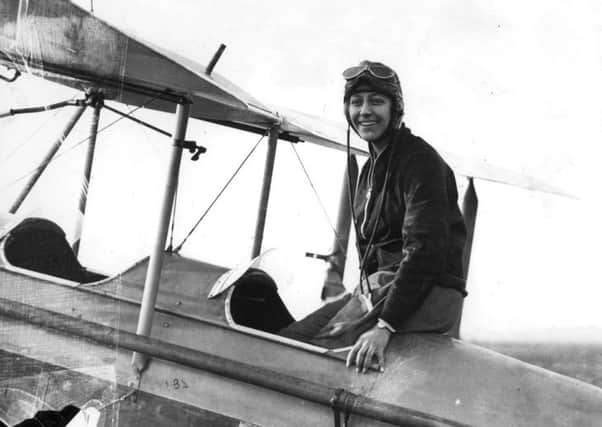Enduring mystery of Amy Johnson’s fate


All that, along with a few other stories – even one that she faked her own death – has somewhat overshadowed her remarkable career as Yorkshire’s pioneer aviator, or in the language of the time, an “aviatrix”.
Born in Hull in 1903, Amy was the daughter of a wealthy fish merchant, and the eldest of three girls. Educated at Hull’s Boulevard Municipal Secondary School she then graduated in 1925 with a Bachelor of Arts degree in General Arts (Latin French, and Economics) from Sheffield University.
Advertisement
Hide AdAdvertisement
Hide AdShe also went to engineering classes and, later, when recalling her time in the city, she said: “I [was] absolutely raw and green burning to see the world and bursting with my own importance. I flirted with the male students, went dance mad, changed and again changed my digs.”
Fellow student Marjorie Wilcockson recalled in 1985: “She had impeccable manners but she was so mouse-like – the last person you would have expected to do anything daring.”
Afterwards Johnson followed various paths, including teacher training and working in London as a secretary to the solicitor William Charles Crocker before boldly taking up flying in 1928 – unusual for a woman at that period.
Learning to fly, navigate and repair engines with the London Aeroplane Club at Stag Lane Aerodrome, she gradually became one of a growing number of female aviators who started to break records and complete pioneering long-distance flights.
Advertisement
Hide AdAdvertisement
Hide AdShe was the first English woman to be granted an Air Ministry’s ground-engineer’s licence in December 1929, achieving the full navigation certificate a year later.
After a little under 16 hours’ tuition she made her first solo flight and achieved her pilot’s ‘A’ licence in July 1929. Then, after 50 hours of solo flying, she gained a ‘B’ licence. At this time there were only around 60 aircraft in private ownership in the country.
The flight that thrilled the world and made her a national heroine was the epic solo journey from Croydon to Australia, which began on May 5 1930. The cost of the aircraft, named Jason – a two-year old De Havilland Moth with a Gipsy engine and fitted with extra fuel tanks – was met by her family and Lord Wakefield, head of the Wakefield-Castrol oil company. He also arranged fuel supplies along the route.
Less than a year after her first solo flight, and with only the experience of flying from London to Hull, she triumphantly covered the 10,000 miles over 20 days to Australia amidst worldwide Press coverage. Although hers was not the fastest time, she was the first solo female pilot to complete the trip. On her return to Croydon, thousands greeted her with a roar.
Advertisement
Hide AdAdvertisement
Hide AdCongratulations were received from King George V and Queen Mary, Ramsay MacDonald, the Prime Minister, the Lindberghs and Louis Blériot. The flight later became the subject of a popular song, Amy, Wonderful Amy, composed by Horatio Nicholls.
Whilst in Australia she had met Scottish pilot Jim Mollison, another pioneering aviator, and a little later she married him, while continuing to make remarkable long-distance flights. In July 1931, with Jason II, she was the first pilot to fly from London to Moscow (and several days later flew to Tokyo); in 1932 she broke a record for a solo flight from England to Cape Town, in a Puss Moth, G-ACAB, named Desert Cloud.
In 1933, an attempted flight with her husband from Carmarthen to New York via Newfoundland and Canada nearly ended in disaster as a lack of fuel saw the plane, a De Haviland DH.84 Dragon I named Seafarer, crash in Bridgeport Connecticut and overturn. The couple were injured but not seriously and it did not stop them flying to India in 1934.
Her last long-distance flight was from Gravesend to Cape Town in May 1936, breaking Flt Lt Tommy Rose’s record, as well as that for the double journey. Rose commented: “It’s a stout show by a very gallant young woman.”
Advertisement
Hide AdAdvertisement
Hide AdJohnson’s honours included the presidency from 1935 to 1937 of the Women’s Engineering Society.
On May 20 1940 she joined the Air Transport Auxiliary (ATA) and ferried aircraft from factory airstrips to RAF bases. While flying from Blackpool to RAF Kidlington, near Oxford on January 5 1941, in an Airspeed Oxford, she allegedly went off course in bad weather and bailed out as her aircraft hit the Thames.
Lt Cmdr Walter Fletcher, of HMS Haslemere, is said to have spotted her parachute coming down and saw her alive in the water. Despite poor conditions and a strong tide, he dived in to rescue her. Tragically, he died and her body was never recovered.
A collection of souvenirs of her was donated by her father at Sewerby Park, Bridlington. The Science Museum, London also has an archive.